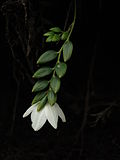| Luzuriaga | |
|---|---|
 | |
| Luzuriaga marginata | |
| Scientific classification | |
| Kingdom: | Plantae |
| Clade: | Tracheophytes |
| Clade: | Angiosperms |
| Clade: | Monocots |
| Order: | Liliales |
| Family: | Alstroemeriaceae |
| Tribe: | Luzuriageae |
| Genus: | Luzuriaga Ruiz & Pav. 1802 |
| Type species | |
| Luzuriaga radicans | |
| Synonyms [1] | |
| |
Luzuriaga is a genus of flowering plants in the family Alstroemeriaceae. It is native to New Zealand, Chile, Argentina and the Falkland Islands. [1] [2] [3] [4] [5]



